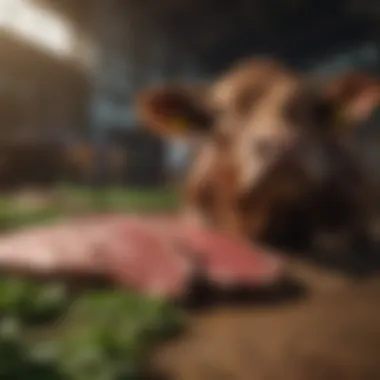Investment Strategies for the Beef Industry


Overview of the Topic
Definition and Importance
The beef industry represents a significant segment of global agriculture, impacting economies, cultures, and diets. Investing in this sector involves understanding not only the production and marketing of beef but also the nuances surrounding animal welfare, environmental sustainability, and consumer preferences. This investment can be crucial for individual farmers, large corporations, and even financial institutions looking to diversify.
Understanding the economic dynamics underlying the beef industry is vital. Changes in consumer demand, global trade patterns, and regulations related to environmental practices all play a role. Investors who grasp these factors can position themselves advantageously, navigating a landscape filled with both opportunities and risks.
Current Trends
Recent trends in the beef industry indicate a shift toward sustainability and ethical farming practices. As consumers become increasingly health-conscious, there's a growing demand for grass-fed and organic beef. Notably, technology adoption is also reshaping the industry, with advancements in livestock tracking and feed management improving efficiency and reducing costs.
Moreover, the global market is witnessing fluctuating prices due to factors like droughts, feed shortages, and changes in international trade policies. Investors should pay attention to these trends as they can significantly affect profit margins and investment returns.
Key Techniques and Practices
Step-by-Step Guide
- Market Research: Understand current market conditions and consumer preferences.
- Identify Opportunities: Look for niches such as organic or grass-fed beef, which may attract premium pricing.
- Establish Networks: Build relationships with suppliers, distributors, and other stakeholders in the industry.
- Implement Technology: Consider investing in modern farming technologies to streamline operations.
- Assess Risks: Analyze potential risks including climate change and market volatility.
Tools and Equipment Needed
- Livestock Management Software: Programs that help track animal health, breeding, and performance.
- Sustainable Feed Solutions: Options that reduce environmental impact and improve livestock health.
- Tractors and Farm Machinery: Essential for land preparation and beef production efficiency.
Challenges and Solutions
Common Obstacles
Investors face several challenges in the beef industry. Fluctuating prices, changing consumer preferences, and regulatory pressures can complicate investment decisions. Additionally, issues related to sustainability and animal welfare increasingly shape public perception and consumer behavior.
Innovative Solutions
Adopting innovative practices can help mitigate some of these challenges. One such example is transitioning to regenerative agriculture, which not only enhances soil health but also improves carbon sequestration. Embracing precision agriculture can also lead to better resource management and productivity.
Investors who adapt to evolving trends will find new opportunities, while those who resist change risk falling behind.
Investments in education and research can also pave the way for advocacy, making sustainability a prioritized focus within the industry. As the global demand for beef continues to evolve, so too must the strategies employed by investors.
Understanding the Beef Industry Landscape
Understanding the beef industry landscape is critical for potential investors aiming to navigate this complex market. The beef industry is not merely a sector of agriculture; it is a multifaceted system that spans the entire value chain, from production to consumption. A deep understanding of this landscape offers insights into market dynamics, consumer behavior, and the various factors affecting investment returns.
This section highlights essential components of the beef industry, allowing investors to make informed decisions. It is important to consider how each segment of the industry interacts with others. For example, shifts in consumer demand can impact production methods, which, in turn, affect investment opportunities. Understanding these relationships aids investors in identifying both risks and opportunities.
Global Market Overview
The global beef market plays a significant role in the overall agricultural economy. According to recent data, countries such as the United States, Brazil, and China dominate the beef trade, with each having its own production methods and consumer preferences. The beef industry globally is influenced by various factors, such as economic stability, import and export regulations, and dietary preferences.
In recent years, there has been a noticeable increase in the demand for premium beef products, particularly in developing markets. This shift represents an opportunity for investors looking to capitalize on high-quality beef production. The global market also faces challenges, such as trade disputes and fluctuations in demand, which can affect pricing and profitability.
Regional Market Dynamics
The dynamics of the beef market can vary significantly between regions. In North America, for example, the focus is often on efficiency and technology, while markets in Asia may prioritize traditional methods and local consumption. Understanding these regional differences is essential for investors who wish to tailor their strategies accordingly.


Investors should also be aware of regulatory conditions which can affect production practices. For instance, regions with stricter environmental regulations may pose challenges for conventional farms but may also attract investors interested in sustainable practices.
Key Trends Impacting Beef Investment
Several trends currently shape the investment landscape in the beef sector. Perhaps most notable is the increasing push for sustainability. As consumers become more environmentally conscious, they are more likely to support producers who adhere to sustainable practices. This could significantly influence investment decisions in the years to come.
Other trends include technological advancements within beef production. Precision agriculture, for example, allows for more efficient resource management, potentially leading to higher returns. Furthermore, advancements in data analytics can provide investors with better insights into market trends, allowing for more informed decision-making.
In summary, a comprehensive understanding of the beef industry landscape is fundamental for investors. It enables them to navigate the complexities of the market effectively, identify opportunities, and manage risks associated with their investments.
Types of Beef Investment
Understanding the different types of beef investments is crucial for anyone looking to enter this sector. Each type offers unique benefits, risks, and considerations. By investing in various facets of the beef industry, investors can spread their risk and take advantage of different market opportunities. This approach enhances the potential for returns and supports a more resilient investment strategy.
Direct Investment in Livestock
Direct investment in livestock involves purchasing cattle for breeding or meat production. This form of investment allows for direct involvement in the beef industry. Investors can gain significant returns if they manage their herds well and keep up with market demands.
Investing in livestock requires attention to breed selection, which can influence the quality of beef produced. Factors such as growth rate, disease resistance, and feed efficiency play an important role in profitability. A clear understanding of market trends is also necessary, as consumer preferences can shift towards certain types of beef, such as grass-fed or organic.
Investing in Beef Production Facilities
Investing in beef production facilities has become an appealing option for many investors. This includes processing plants and feedlots. By acquiring or investing in these facilities, investors can benefit from economies of scale and operational efficiencies.
The benefits of investing in production facilities are substantial. These facilities can handle large volumes of cattle, leading to reduced per-unit costs. However, this type of investment requires significant capital. Also, investors must be aware of local regulations and industry standards to ensure compliance and sustainability. Market positioning is important; being close to supply sources can enhance efficiency and cut transport costs.
Investing in Supply Chains
The beef supply chain is a crucial link between producers and consumers. Investing in supply chains, which includes logistics, distribution, and marketing, can be a valuable strategy. It enhances the value of beef products while ensuring their arrival to the marketplace in optimal condition.
Many aspects come into play when investing in supply chains. Effective logistics can minimize waste and improve margins. Additionally, understanding market trends allows investors to pinpoint where demand is highest. For instance, investing in cold storage facilities or transportation can significantly impact the freshness and quality of beef. This can lead to increased consumer satisfaction and loyalty.
Publicly Traded Companies in the Beef Sector
Investing in publicly traded companies provides exposure to the beef industry without the need to manage livestock directly. These companies may include large beef production businesses, retailers, or ancillary service providers. Notable examples include Tyson Foods and JBS S.A.
This form of investment appeals to those seeking liquidity and diversification. Investors can analyze financial statements, market performance, and industry trends. However, investing in stocks also carries risks associated with market volatility and individual company performance. It's important for investors to stay informed on both macroeconomic factors and specific company developments. Understanding the larger market dynamics can aid in making informed decisions.
"Diverse investments in the beef industry can provide a safety net against market fluctuations while maximizing potential returns."
By exploring these various types of beef investments, investors can create a well-rounded strategy tailored to their goals and risk tolerance. The key is to approach each investment option with careful consideration and informed decision-making.
Economic Factors Influencing Investment
Understanding the economic factors that influence investments in the beef industry is essential for making informed decisions. Factors such as market demand, pricing trends, and trade policies can significantly impact profitability and investment success. Identifying these elements allows investors to anticipate market changes, adapt their strategies, and optimize returns.
Market Demand and Consumer Preferences
Market demand is a key driver in the beef industry. Changes in consumer preferences reflect shifts in dietary habits, health consciousness, and sustainability concerns. For instance, there has been a growing trend towards grass-fed beef and organic options as consumers prioritize health and ethical considerations. This trend influences not only how beef is produced but also the types of investments that may yield better returns. Investors should actively monitor demand fluctuations to align their strategies accordingly.
- Key elements of market demand include:
- Consumer health preferences
- Environmental impact awareness
- Economic conditions influencing disposable income


Investing in brands that address these consumer preferences could offer significant advantages. Additionally, understanding the demographics of beef consumers can help investors make more strategic decisions.
Price Fluctuations and Their Effects
Price fluctuations within the beef market can create both risks and opportunities. Beef prices are subject to various influences, including feed costs, supply chain disruptions, and overall market demand. For example, if livestock feed prices increase, the costs for beef production will rise, potentially driving up market prices. Conversely, high prices can lead to reduced consumer demand, impacting profitability.
Price stability is crucial for long-term investment planning. Investors must analyze historical price trends to anticipate future movements and make educated decisions regarding when to enter or exit the market.
To manage the impact of price volatility, strategies may include:
- Hedging: Using contracts or financial instruments to protect against price drops.
- Diversification: Investing across different sectors within the beef industry can mitigate risks associated with price declines in one area.
Impact of Trade Policies
Trade policies significantly influence the beef industry by shaping market accessibility and costs. Tariffs, import/export restrictions, and bilateral agreements can alter the dynamics of international trade, affecting prices and profitability. For example, restrictive trade policies might limit market access for beef producers, resulting in lower sales and revenues.
Keeping abreast of trade policy developments is vital for investors. Monitoring legislative changes and their implications can provide insights into the best investment timing and strategy. Investors should consider:
- Potential trade agreements that could open new markets.
- Changes in tariffs that might increase costs for imported beef.
Sustainability Considerations
In the beef industry, sustainability is a critical element that shapes investment strategies. As the world increasingly recognizes the importance of environmental stewardship, investors are starting to scrutinize practices that conserve natural resources and promote ethical standards in beef production. This focus on sustainability brings several benefits, impacting investment decisions and market positioning.
The sustainable practices adopted by beef producers can enhance the long-term viability of farms. They often lead to better resource efficiency, reduced waste, and lower greenhouse gas emissions. Investors are keen on strategies that limit environmental degradation while meeting the growing consumer demand for responsible sourcing.
Environmental Impact of Beef Production
Beef production has significant environmental implications. Land usage, water consumption, and greenhouse gas emissions are high in traditional cattle farming. This raises concerns among both consumers and investors regarding the sustainability of the beef supply chain. Understanding these impacts is imperative for investors looking to align finances with sustainable practices.
Producing beef requires considerable land and water resources, largely due to grazing and feed crop cultivation. Additionally, cattle emit methane, a potent greenhouse gas that contributes to climate change. Efforts to mitigate these impacts are central to the current discourse on sustainability in the beef sector. Technologies like rotational grazing or improved feed efficiency can help reduce these environmental consequences.
Consumer Shift Towards Sustainable Practices
In recent years, there has been a notable shift among consumers towards sustainable beef products. This trend mirrors a broader societal movement that values transparency and ethical production standards. Understanding this shift can guide investors in selecting opportunities that align with consumer preferences and support sustainability in cattle farming.
Sustainable Farming Practices
Sustainable farming practices focus on minimizing negative environmental effects while maintaining productivity. These approaches include integrated pest management, organic farming methods, and grass-fed operations. A key characteristic of these practices is their adaptability; they can be tailored to specific farm conditions and local ecosystems. This flexibility makes them a favored choice among producers looking to invest in the future.
The unique feature of sustainable farming is the integration of environmental care with agricultural productivity. By promoting soil health, conserving water, and reducing chemical use, these practices foster resilience against climate variability. While sustainable methods may require higher initial investments, the long-term benefits categorically outweigh the costs.
Grass-Fed vs. Grain-Fed Beef
The debate between grass-fed and grain-fed beef is central to discussions about sustainability. Grass-fed cattle often graze on pastures, which can lead to reduced environmental impact compared to grain-fed operations that rely on intensive feedlot systems. A key characteristic of grass-fed beef is its potential for improved animal welfare and lower carbon footprints. This makes it a popular choice among environmentally conscious consumers.
However, there are unique challenges associated with grass-fed cattle. These include longer timeframes for weight gain and the potential for lower overall yields. Investors should weigh these advantages and disadvantages carefully when considering beef production opportunities. Grain-fed beef, while often more efficient in production, raises questions about sustainability due to higher resource inputs.
Certifications and Labels
Investors should also pay attention to certifications and labels that indicate sustainable practices. These indicators provide transparency regarding how beef is produced, ensuring compliance with certain environmental and ethical standards. Labels like USDA Organic, Certified Humane, and Global Animal Partnership signify adherence to sustainable methods which can enhance market appeal. They often influence consumer purchasing decisions, making it essential for investors to understand their importance in the market.
Risks Associated with Beef Investment


Understanding the risks associated with beef investment is essential for any investor contemplating entry into this sector. The beef industry can be both profitable and volatile, influenced by many factors. Recognizing these risks not only helps investors safeguard their capital but also enhances their decision-making capabilities. This section outlines significant risks, offering a deeper insight into what potential investors should watch for.
Market Risks
Market risks refer to the uncertainties and fluctuations in beef prices influenced by various external factors. These can include changes in supply, consumer demand, and global market conditions. For instance, fluctuations in feed prices can lead to higher costs for producers. When feed becomes more expensive, cattle producers may face squeezed margins, which can ultimately be reflected in beef prices.
Moreover, global competition can also dictate market trends. If countries with lower production costs increase their beef exports, it can reduce demand for domestic beef. Such changes can result in price reductions that impact profits for investors.
Operational Risks
Operational risks encompass the challenges and uncertainties associated with the daily operations of beef production. These can range from management inefficiencies to issues with livestock health. An outbreak of disease among cattle can create significant financial liabilities and disrupt the supply chain. Furthermore, poor management practices could lead to decreased productivity, affecting the profitability of investments.
Advanced technology adoption, such as precision farming techniques, is critical in mitigating operational risks. Utilizing data analytics can enhance operational efficiency and reduce losses. Investors should remain vigilant about how systems are managed to ensure optimal performance.
Regulatory Risks
Regulatory risks involve the potential impacts of changing laws and regulations on the beef industry. With growing concerns about food safety and animal welfare, governments may enact stricter regulations. Compliance with these regulations can incur additional costs for beef producers and other stakeholders, profoundly impacting investment returns.
Changes in trade policies also fall under this category. Tariffs and trade regulations can affect the price and availability of beef in international markets, influencing decision-making for investors. Staying informed about legislative changes and industry standards is crucial in navigating these risks effectively.
Investors must conduct thorough research to understand the potential risks associated with beef investments. Only through informed decisions can they maximize their returns and minimize losses.
By carefully analyzing these risk factors, investors can make more strategic decisions in their beef investment endeavors. This understanding will guide their choices, setting a solid foundation for a successful investment in the beef industry.
Investment Strategies
In the context of the beef industry, investment strategies represent a critical component for stakeholders. Investors must consider various factors to make informed decisions that can lead to sustainable growth. Given the complexities of this market, effective strategies help mitigate risks while maximizing opportunities. These strategies allow for a more structured and calculated approach to investments in livestock, production facilities, and related technologies.
Diversification in Beef Investment
Diversification is a key strategy that helps distribute investment risk. Investors can diversify by engaging in various aspects of beef production such as direct livestock purchases, shares in beef processing, and involvement in supply chains. This approach can also extend into geographical diversification, minimizing exposure to risks linked to specific markets or regions. By spreading investments across different segments, investors can protect themselves against localized downturns. Furthermore, diversification can enhance overall returns by capitalizing on multiple revenue streams.
Long-Term vs. Short-Term Investments
Deciding between long-term and short-term investment strategies is crucial for investors in the beef industry. Long-term investments generally involve committing to the production processes and facilities, yielding returns over an extended period. This approach is often more aligned with sustainable practices that are becoming prevalent in the industry. On the other hand, short-term investments may focus on quick market trends, such as fluctuations in beef prices. Each strategy has its benefits; therefore, careful evaluation is needed to choose the right approach according to individual investment goals.
Leveraging Technology in Investment Decisions
Modern investors are increasingly leveraging technology in their decision-making. Incorporating data analytics and precision agriculture can lead to more informed investments that align with market demands and trends.
Data Analytics for Market Trends
Data analytics plays a significant role in understanding market trends within the beef industry. By analyzing historical and current data, investors can identify consumer behaviors and predict future demand patterns. This aspect is crucial because it enables investors to align their strategies with market requirements. A key characteristic of data analytics is its capacity to provide real-time insights, making it a highly beneficial choice for stakeholders looking to optimize their investments. However, the challenge lies in the interpretation of data; improper analysis might lead to misguided investment choices.
Precision Agriculture Techniques
Precision agriculture involves using technological tools to increase the efficiency of farming practices. This method allows investors to monitor livestock health and resource distribution more closely. A defining characteristic of precision agriculture is its focus on optimizing inputs such as feed, water, and health measures based on real-time data. This technique can lead to cost savings and improved productivity, making it a powerful investment avenue. However, it requires a commitment to adopting new technologies, which might pose initial cost barriers for some investors.
End
In the context of the beef industry, the conclusion serves as a pivotal part of the investment narrative. Evaluating one’s investment approach is not just about assessing past performance; it also involves a forward-thinking strategy that takes into consideration numerous factors, including market trends, sustainability challenges, and shifting consumer preferences. By reflecting on these aspects, investors can refine their strategies for better alignment with the industry’s dynamics.
Furthermore, understanding the future outlook for beef investments is essential for strategically positioning within the market. With the increasing influence of technology and data analytics, investors can gain invaluable insights into market movements. It is crucial to look ahead, as predicting future trends can lead to informed decision-making and greater investment success.
Choosing the right strategies will help to mitigate risks and position investments favorably for both short-term gains and long-term stability. As the beef market shifts due to economic and environmental pressures, being proactive rather than reactive becomes a key element of success. Hence, continuous education and adaptation in investment approaches become vital for those involved in this expansive sector.
"The beef industry offers a rich tapestry of investment opportunities, but recognizing the inherent risks connected to market volatility and sustainability pressures is essential for making informed decisions."
Ultimately, the beef sector will continue to evolve. Investors need to stay informed about both current and future trends. This enables not just survival, but thriving in a complex and competitive marketplace.



